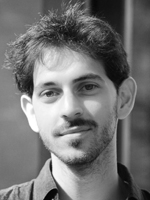Giuseppe Tateo, PhD

Areas of interest
- Religion and Ritual
- Eastern Christianity
- Urban Anthropology
- Post-Socialism
- Ethnographic Theory
- History of Anthropology
- Migration Studies
- Romania and Moldova
Church-building after socialism: an overview
In recent years, my research has focused on the impressive growth of the church-building industry in Romania. In contrast to other secular contexts in Europe, where forms of individualisation of faith have gone hand in hand with secular normativity in the public space, the last three decades in Romania have seen an impressive increase in religious visibility: several religious monuments have been installed in the capital, and about ten thousand houses of worship and over thirty cathedrals built in the country as a whole.
While in Leipzig, I will frame the Romanian case in a broader context, considering the expansion of religious infrastructure throughout eastern and central Europe since 1991. The term ‘religious infrastructure’ refers not only to houses of worship, but also to sanctuaries, monasteries, national cathedrals, monuments, etc. Starting from the assumption that religion did not disappear during socialism and reappear after it, but rather “endured and flourished” (Steinberg and Wanner 2008: 6), my research will consider how to understand the resurgence in religious infrastructure in post-socialist Europe beyond the paradigm of religious revival, as well as the ways in which the nationalist features of the newly built cathedrals in central and eastern Europe act as secularising forces. The boom in religious infrastructure in various post-socialist countries has caused some observers to talk of religious revival, sacralisation, revitalisation, or renewal, linking the visibility of religious symbols and edifices with a growth in faith, belonging and practice. However, the powerful return of religious signifiers to the public arena was also accompanied by unprecedented criticism, inchoate forms of anticlericalism and new modes of coexistence between secularist sentiments, religious identification and spiritual practice. In modern-day eastern Europe, the construction of religious infrastructure is a topic that relates to far more than pastoral or liturgical needs.
Religious buildings and monuments are often a tool for political regimes to gain cultural and historical legitimacy. The politics of memory of the recent socialist past particularly operate through the modification of the built environment: monuments are replaced, museums and churches erected, and crosses planted to whitewash specific public institutions and put them on the right side of history. After the demise of state socialism, the ambitions of political actors, ready to capitalise on the resurgence of nationalist sentiments, met those of Orthodox and Catholic church leaders eager to restate the prominence of majority churches in a religious market that was on the way to pluralisation.
Newly built national cathedrals in Moscow (2000 and 2020), Bucharest (2018), Tbilisi (2004) and Warsaw (2016) epitomise this process well. Such grandiose buildings – rather than standing for a grassroots-driven religious revival or signalling the dawn of a new postsecular era – celebrate the unity between the religion of the majority, the state and national belonging. Thirty years after the end of the socialist experiment, the time is ripe to compare church-building patterns throughout the former socialist bloc, and tackle this growing religious visibility with new theoretical tools.
Biography
Visiting Researcher, Institute of Sociological Studies, Charles University Prague, Czech Republic
Lecturer, Department of Communication Studies, Rīga Stradiņš University, Latvia
Postdoctoral Fellow, UEFISCDI Award Program. New Europe College, Bucharest,
Romania
Surveyor at Fondazione Rodolfo Debenedetti, Milano, Italy
PhD in Social Anthropology, Max Planck Institute for Social Anthropology, Martin
Luther Universität Halle-Wittenberg, Germany
Relevant Publications
- Tateo, Giuseppe. “A Few Things the Church-Building Industry Tells Us About ContemporaryRomania.” New Europe College Yearbook 2019-2020 (forthcoming).
- Tateo, Giuseppe. “When Conspiracy Meets Faith: Making Sense of Tragic Events in Bucharest.” In Religious Dimensions of Conspiracy Theories: Connecting Old and New Trends. Edited by Francesco Piraino, Marco Pasi and Egil Asprem., (forthcoming).
- Tateo, Giuseppe. “New Cathedrals in Postsocialist Europe: Turning Chance into Destiny.” In Politics of Religion: Secularity, Atheism, Conflicts. Edited by Tobias Köllner and Alessandro Testa. Berlin: LIT, 2021.
- Tateo, Giuseppe. “Bless to Spoil: Revanchism, Nationalism and Defilement in an Anti-Mosque Ritual in Bucharest, Romania.” Historia Religionum, no. 12 (2020): 149–64.
- Tateo, Giuseppe. “Romanian Orthodox Church.” Database of Religious History, 2020.
- Tateo, Giuseppe. “Scalar Holism: Some Methodological Reflections on Bucharest's Religious Megaprojects.” ANUAC 5, no. 1 (2020): 129–49.
- Tateo, Giuseppe. Under the Sign of the Cross: The People’s Salvation Cathedral and the Church Building Industry in Postsocialist Romania. New York: Berghahn Books, 2020.
- Tateo, Giuseppe. “Viktor Shklovsky, Bronislaw Malinowski, and the Invention of a Narrative Device: Implications for a History of Ethnographic Theory.” Journal of Ethnographic Theory 10, no. 3 (2020).
- Tateo, Giuseppe. “Croci Contro La Moschea: Profanazione E Riconversione Di Uno Spazio Indivisibile.” Annali di studi religiosi, no. 20 (2019): 105–21.
- Tateo, Giuseppe. “Substitution, Secession and Negotiation: Reading the Post-Soviet Chişinău.” In Identitatile Chisinaului. Edited by Sergiu Musteata, 178–87. Chişinău: Editura ARC, 2015.


